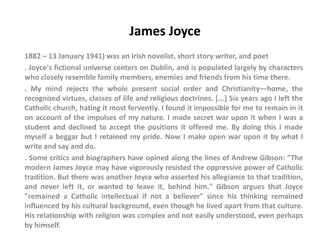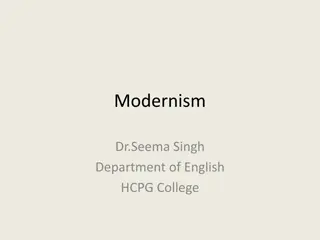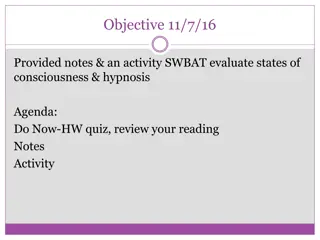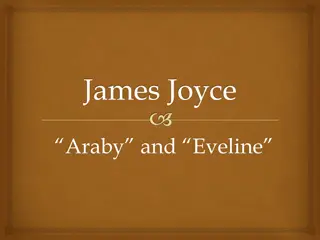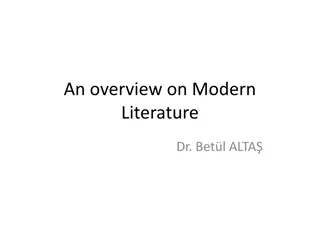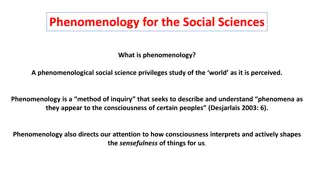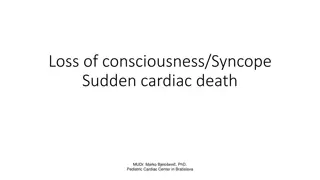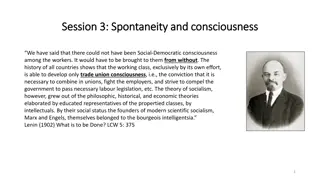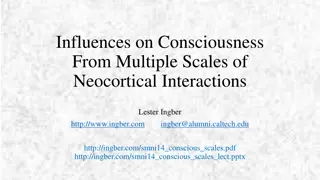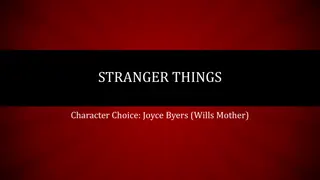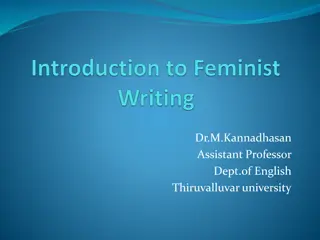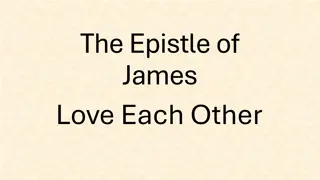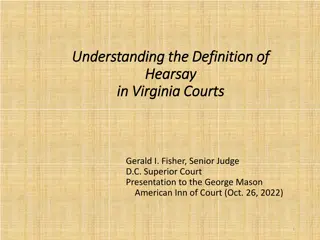Understanding Stream of Consciousness in Literature: Examples from James Joyce and Virginia Woolf
Stream of consciousness is a narrative technique capturing the flow of characters' thoughts. James Joyce's "Ulysses" delves into Leopold Bloom's introspections, while Virginia Woolf's "Mrs. Dalloway" explores internal feelings. These examples showcase the vivid use of this literary device.
Download Presentation

Please find below an Image/Link to download the presentation.
The content on the website is provided AS IS for your information and personal use only. It may not be sold, licensed, or shared on other websites without obtaining consent from the author. Download presentation by click this link. If you encounter any issues during the download, it is possible that the publisher has removed the file from their server.
E N D
Presentation Transcript
STREAM OF CONSCIOUSNESS DEFINITION In literature, stream of consciousness is a method of narration that describes in words the flow of thoughts in the minds of the characters. The term was coined was initially coined by a psychologist William James in his research The Principles of Psychology . He writes: it is nothing joined; it flows. A river or a stream is the metaphors by which it is most naturally described. In talking of it hereafter, let s call it the stream of thought, consciousness, or subjective life.
INTERIOR MONOLOGUE Another appropriate term for this device is Interior monologue where the individual thought process of a character associated to his or her actions are portrayed in form of a monologue the addresses the character itself. Therefore, it is different from the dramatic monologue or Soliloquy where the speaker addresses the audience or the third person.
STREAM OF CONSCIOUSNESS EXAMPLES IN STREAM OF CONSCIOUSNESS EXAMPLES IN LITERATURE LITERATURE The Stream of Consciousness style of writing The Stream of Consciousness style of writing is marked by the sudden rise of thoughts and is marked by the sudden rise of thoughts and lack of punctuations. The use of this narration lack of punctuations. The use of this narration mode is generally associated with the modern mode is generally associated with the modern novelist and short story writers of the 20th novelist and short story writers of the 20th Century. Let us analyze a few examples of the Century. Let us analyze a few examples of the narrative technique in literature: narrative technique in literature:
JAMES JOYCE 1. James Joyce successfully employs the narrative mode in his novel Ulysses which describes the day in life of a middle-aged Jew, Mr. Leopold Broom, living in Dublin, Ireland. Read the following excerpt: He is young Leopold, as in a retrospective arrangement, a mirror within a mirror (hey, presto!), he beholdeth himself. That young figure of then is seen, precious manly, walking on a nipping morning from the old house in Clambrassil to the high school, his book satchel on him bandolier wise, and in it a goodly hunk of wheaten loaf, a mother s thought. These lines reveal the thoughts of Bloom. He thinks of the younger Bloom. The self-reflection is achieved by the flow of thoughts that takes him back to his past.
VIRGINIA WOOLF Another 20th C writer is Virginia Woolf. Let us read an excerpt from her novel Mrs. Dalloway : What a lark! What a plunge! For so it always seemed to me when, with a little squeak of the hinges, which I can hear now, I burst open the French windows and plunged at Bourton into the open air. How fresh, how calm, stiller than this of course, the air was in the early morning; like the flap of a wave; the kiss of a wave; chill and sharp and yet (for a girl of eighteen as I then was) solemn, feeling as I did, standing there at the open window, that something awful was about to happen By voicing their internal feelings, the writer gives freedom to the characters to travel back and forth in time. Mrs. Dalloway went out to buy flower for herself and on the way her thoughts moves in past and present giving us an insight into the complex nature of her character.
FUNCTION OF STREAM OF CONSCIOUSNESS FUNCTION OF STREAM OF CONSCIOUSNESS It is a style of writing developed by a group of writers at the beginning of the 20th century. It aimed at expressing in words the flow of a character s thoughts and feelings in their minds. The technique aspires to give readers the impression of being inside the mind of the character. Therefore, the internal view of the minds of the characters sheds light on plot and motivation in the novel.




